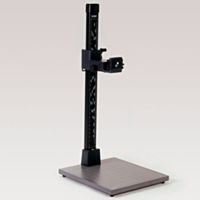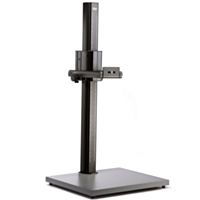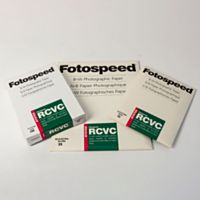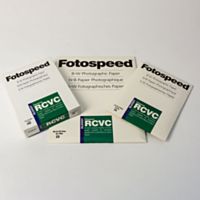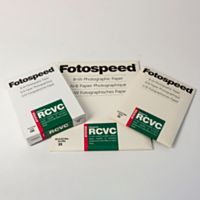Fotospeed ST20 Sepia Toner 150ml Makes 1.5Litres - Fotospeed
Fotospeed ST20 Sepia Toner 150ml Makes 1.5Litres
Fotospeed ST20 Sepia Toner will produce a fixed sepia tone on both Fibre and Resin Coated B&W papers. It comprises two parts : Part1 - Bleach & Part 2 - Toner. Each part mixes separately to make two working solutions. This toner will give a traditional sepia colour with no control over the colour.
MIXING INSTRUCTIONS
Part 1: Bleach - Dilute 1+9 with water to make the volume of working solution.
Part 2: Toner - Dilute 1+9 with water to make the volume of working solution.
USAGE
Having selected the print to be toned ensure that it has been fully fixed and washed. In the case of dry prints, first soak them in water for 1 minute to ensure even take up of bleach.
1 . Place the print in the bleach bath and agitate gently. Bleaching times may vary according to paper type.
2. After bleaching, place the print into running water for 1 minute for RC paper and 5 minutes for fibre paper.
3. Place the print into the toner bath, agitate gently and observe the image re constructing. Full toning will be completed in 1 minute with fresh solution.
4. Finally wash the print in running water. Wash RC papers for 2 minutes and fibre papers for 20 minutes.
CAPACITY
Both the Bleach and Toner working solutions can be kept for reuse in airtight containers. Both solutions will however deteriorate once used and a slow-down in activity should be anticipated together with a colour shift in the toner on subsequent prints. To maintain consistency of sepia tone, it is advisable to make up only small quantities (approx. 200mls) of working solution at a time. After putting 5 - 8x10 prints through 200mls of solution, it will become exhausted. Each litre should process 25 - 8x10 prints assuming average density.
PRINT QUALITY
If there is any doubt that the print to be toned has been fully fixed and washed, it should be refixed and rewashed thoroughly before beginning toning. Staining on a toned print can result from the print having been inadequately fixed and washed before hand .
Variable contrast papers may be slow to react with the bleach. If this occurs extend the bleaching time or make the bleach more concentrated. The whole procedure should be done under normal room or daylight conditions.
Fotospeed ST20 Sepia Toner will produce a fixed sepia tone on both Fibre and Resin Coated B&W papers. It comprises two parts : Part1 - Bleach & Part 2 - Toner. Each part mixes separately to make two working solutions. This toner will give a traditional sepia colour with no control over the colour.
MIXING INSTRUCTIONS
Part 1: Bleach - Dilute 1+9 with water to make the volume of working solution.
Part 2: Toner - Dilute 1+9 with water to make the volume of working solution.
USAGE
Having selected the print to be toned ensure that it has been fully fixed and washed. In the case of dry prints, first soak them in water for 1 minute to ensure even take up of bleach.
1 . Place the print in the bleach bath and agitate gently. Bleaching times may vary according to paper type.
2. After bleaching, place the print into running water for 1 minute for RC paper and 5 minutes for fibre paper.
3. Place the print into the toner bath, agitate gently and observe the image re constructing. Full toning will be completed in 1 minute with fresh solution.
4. Finally wash the print in running water. Wash RC papers for 2 minutes and fibre papers for 20 minutes.
CAPACITY
Both the Bleach and Toner working solutions can be kept for reuse in airtight containers. Both solutions will however deteriorate once used and a slow-down in activity should be anticipated together with a colour shift in the toner on subsequent prints. To maintain consistency of sepia tone, it is advisable to make up only small quantities (approx. 200mls) of working solution at a time. After putting 5 - 8x10 prints through 200mls of solution, it will become exhausted. Each litre should process 25 - 8x10 prints assuming average density.
PRINT QUALITY
If there is any doubt that the print to be toned has been fully fixed and washed, it should be refixed and rewashed thoroughly before beginning toning. Staining on a toned print can result from the print having been inadequately fixed and washed before hand .
Variable contrast papers may be slow to react with the bleach. If this occurs extend the bleaching time or make the bleach more concentrated. The whole procedure should be done under normal room or daylight conditions.



